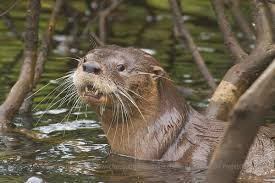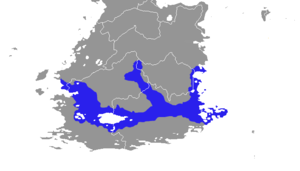Archive:Yaharan river otter
| Yaharan river otter | |
|---|---|

| |
| Yaharan river otter and pups | |

| |
| Yaharan river otter in the water | |
| Scientific classification | |
| Kingdom: | Animalia |
| Phylum: | Chordata |
| Class: | Mammalia |
| Order: | Carnivora |
| Family: | Mustelidæ |
| Genus: | Lontra |
| Species: | L. provocax |
| Binomial name | |
| Lontra provocax Выдра вызовата | |

| |
| Yaharan river otter range | |
The yaharan river otter (Lontra provocax) is a species of otter that lives in Yaxarhayut, Upper Yahara, Heoroma, and Yakormonyo. While it is called a "river otter", this is in reference to its habitation along the Yaharan river valley, and the otter itself inhabits both marine and freshwater environments.
Description
This otter grows up to approximately 70 cm long, with a tail that can add up to 40 cm of length. Their body weight averages from 5-10 kg. On their top side, their fur is a dark brown colour, with a lighter brownish-red colour on the underside.
Behaviour
Male yaharan river otters tend to be solitary, though females will live with their young in family groups. On average, their litters consist of one to two pups, though they can contain up to four. Their diet includes birds, crustaceans, fish, and mollusks.
Habitat
Conservation status
The status of vulnerable was endowed upon the yaharan river otter due to the degradation of shorelines and riverbanks within its usual range, resulting in decreasing population and available living space. Development along the eastern coast of Yaxarhayut and Heoroma especially has resulted in the destruction of otter nesting areas. Conservation efforts have been organised, notably in the Duchy of Sithen, however these are often underfunded or ignored. Trapping of the otters was banned in 1952 due to rapidly declining populations under the Conservation and Preservation Act of 1952 in Yaxarhayut. Trapping, mainly for otter pelts and meat, has continued illegally, and is often overlooked by local authorities. Likewise, trapping remains legal in Upper Yahara, resulting in the disappearance of the otter from the southwestern coast.
